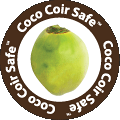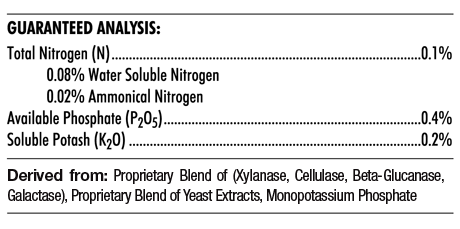-
SensiZym
Advanced Nutrients
Avaliação 3.9/5 baseada em 7 voto(s)
Ver descrição completaSensiZym es un superconcentrado de más de 80 enzimas, cada una de las cuales tiene funciones específicas que intensifican el crecimiento de las plantas y sus raíces.
-
-

- Advanced Nutrients Ver outros produtos
-
Descrição do produto
-

Algunas de estas encimas, ayudan a catalizar el agua y asisten en la transferencia de elementos nutritivos a lugares específicos. Otras, hacen que los procesos reguladores de las plantas sean más veloces, o ayudan a la replicación celular. Las enzimas pueden hacer en segundos o minutos lo que las funciones normales de la planta realizan en días o semanas. La mayoría de las mejores formulas competidoras del mercado actual contienen 12 enzimas o incluso menos; Sensizym contiene el triple de unidades de actividad que su competidor más cercano.
Mediante la ruptura de raíces muertas, almidones, carbohidratos y nutrientes, Sensizym acelera el crecimiento de la planta y ayuda al desarrollo de bacterias beneficiosas. Los productos con enzimas de la competencia sólo rompen la materia radicular muerta; Sensizym, además, cataliza el desarrollo total de la planta y sus raíces.
PRECAUCIÓN: Una vez abierta la botella se aconseja guardar en el frigorífico.
If you want to improve the nutrient health of your plants and maximize growth and yields, use Sensizym. This concentrated enzyme product enhances the uptake of nutrients and other beneficial elements. Containing far more enzymes than products from other manufacturers, Sensizym provides truly superior results. By reconditioning soil and improving nutrition, Sensizym maximizes growth, enhanced drought resistance, and aids in producing better harvests.
• Enhances utilization of water and water-borne elements
• Contains over 80 enzymes required by plants
• Incorporates cellusase enzymes
• 300% more potent than products from other manufacturers
• Has the longest shelf life of all enzymatic products
It's easy to use this advanced enzyme product. When applying Sensizym to soil or sphagnum moss, simply mix 5 ml of product per litre of water for every watering. Apply this mixture every week throughout the vegetative and flowering cycles. For hydroponics use, mix 5 ml of Sensizym per litre into the nutrient reservoir. Once again, use every week during the vegetative and flowering phases. That's all it takes to achieve the incredible results provided by Sensizym.
SensiZym - Points of Difference
1. Has the longest shelf life (18 months) of all enzymatic products as a result of properly balanced engineering.
2. Is the only product on the market that incorporates cellusase enzymes (enzymes that digest dead protein matter and turn it into a bio-active form that can be utilized by the plant).
3. Enzymes eat dead root matter and remove the possibility for pythium and phytophythoria to develop.
4. Contains over 80 different enzymes - our competitor's products contain a maxumum of only 12.
SensiZym - Frequently Asked Questions
Q. I've heard that I can reuse my media if I apply Sensizym - is this true?
It certainly is, especially when growing with soilless media such as Sunshine Mix #4.
There are active enzymes in Sensizym that break down dead protein matter (i.e. roots left over after harvest) that would normally provide a home for pathogens. The enzymes essentially "re-sterilize" the media and prepare it for reuse. As a double-bonus, the dead roots are transformed by the enzymes into bio-available nutrients that can be utilized by your next crop.
Q. How does Sensizym prevent infestation of pathogens in my media?
Specific enzymes in Sensizym "eat & digest" dead protein matter, effectively removing the the food source that pathogens rely on to proliferate. No food source = no pathogens = no infestation.
Q. Can I use Hy-Ox with beneficial cultures? (SensiZym, Piranha , Tarantula , Voodoo Juice)
Absolutely not... Hy-Ox will damage or kill the beneficial cultures (Piranha , Tarantula , Voodoo Juice) and may seriously affect the effectiveness of Sensi zym
Q. I've heard that the shelf-life of Sensizym is 18 months. All other products out there seem to have a maximum shelf-life of 12 months. How is it that Sensizym has such a longer shelf life than all of it's competitors?
Advanced Nutrients R & D has put an extraordinary amount of time and resource into 'balancing' the specific types and quanitities of enzymes that are found within Sensizym. Without precise engineering the 80 different enzymes would cannabilize each other, rendering the product ineffective (which is why many of our competitors enzymatic products have short shelf lives).
Q. Can I use Sensizym on my outdoor crop and if so, what is the application rate?
Sensizym is a completely natural product that can be used safely on all indoor and outdoor crops. Apply the at the same rate of 5mL / Litre (1 tsp. / quart).
Q. Can I use Sensizym on my compost pile to speed up the decomposition process?
Absolutely. Apply periodically at 5 mL / Litre (1 tsp. / quart) to facilitate decomposition.
SensiZym - Growing Tips
Use Sensizym as a preventative measure to avoid pythium and phytophythoria.
Sensizym can be applied on soil / soiless media after harvest and the media can be reused.
Hy-Ox will damage or kill the beneficial cultures (Piranha, Tarantula, or Voodoo Juice) and may seriously affect the effectiveness of Sensizym
SensiZym - Technical Description
The Advantages of Using Sensizym:
Enzymes are the molecular machines inside cells that literally create the living organism, but they are also the mechanism nature uses to disassemble herself. Enzymes will digest their environment as well as re-assemble it when new life grows from old.
Sensizym is a concentrate of nature's most powerful 'digestive' enzymes for reconditioning soil and growing media to a pre-biotic state; Sensizym will disassemble every shred of previous microbial, plant and insect life in your growing media rendering it back to a state of being molecular precursors for growth.
The effects of Sensizym prepares the soil as Nature would after a growing season. However Sensizym runs this process of enzymatic digestion much faster, and virtually immediately when at room temperature. Sensizym completes in hours what nature does in months, or over-winter!
After a vigorous growing cycle is complete, there are copious amounts of nutrients locked up in root and microbial tissues in the growing media. There is also a background of pathogenic fungi and soil-borne insects and pests like nematodes and mites harboured in the growing media after every crop cycle. Sensizym totally digests all these pathogens on contact, and solubilizes their tissues for use in the next season of growth.
The key enzymes in Sensizym include types of chitinases, proteases, hydrolases glucanases and cellulases; these are the molecules that can split apart the complex carbohydrate chains that make up fungi and plant cell walls. These enzymes classes all go 'to work' immediately upon contact with their respective substrates, and molecularly tear them into their individual components, or single sugars.
Sensizym is a formulation of purified digestive enzymes that are made by all natural soil microbes; Advanced Nutrients has simply concentrated these into a usable form for gardeners. Scientists who study the health of soil ecosystems make direct measure of the abundance of these enzymes, and we can turn to their investigations to learn, more about the powerful molecular machines found in Sensizym.
Soil Biology is Enzyme Biology:
Soil is a mostly living material; it contains the roots of plants, fungi, bacteria insects, invertebrates that all consume the raw resources available. After decades of study soil ecologists have made complex models to account for the movement of nutrients from soils containing multitudes of organisms into crops and the atmosphere. But It has been a recent advancement of soil scientists to directly measure the enzymatic activity of soils to deduce their level microbial diversity.
Advanced Nutrients has adapted the knowledge accumulated in decades of modern soil science to formulate Sensizym to include the most potent and useful classes of these soil enzymes. We have combined many commercial sources for all the most common enzymes found in healthy soil and then concentrated them into Sensizym.
One study that we can turn to find an example of how enzymatic activities of soils are measured to reveal their over all health is found in the Canadian Journal of Forest research, vol.29 (1999). The authors of the article entitled 'Scale-dependent patterns of soil enzyme activity in a forested landscape' introduce the topic of soil 'decomposition models' and how this has now become a study in enzyme biology. They say:
'The processes of decomposition, mineralization, and humification of organic matter deposited on and in the forest floor and surface soil layers by plant tissue mortality have been among the most intensively studied of ecosystem processes. Syntheses of studies of the rates, patterns, and environmental influences on decomposition and mineralization have been available for more than two decades (e.g., Swift et al. 1975), and decomposition models designed to operate at global scales have also been developed (e.g., Meentemeyer 1978). In recent years, the analysis of these processes has focused on the fine-scale, microbially mediated processes that actually drive the mineralization and humification processes in the expectation that models with such resolution will be more robust than will models based on broad-scale outcomes. In particular, measurement of various enzyme systems produced by a wide range of soil microbes and fauna has become common in agro-ecosystem research for classification and diagnosis of soils under agriculture (Burns 1983; Sinsabaugh 1994) and for describing organic matter dynamics in aquatic systems (Sinsabaugh et al. 1994).'
Advanced Nutrients has seized upon this knowledge to create Sensizym. In Sensizym we have concentrated many classes of decomposing enzymes secreted as 'exoenzymes' by beneficial soil microbes. The soil scientists continue to describe these enzymes:
'The enzymes quantified in such studies are manufactured by bacteria, fungi, and other soil microorganisms, most often in response to both the quantity and biochemical characteristics of the organic material available for metabolism. These enzymes are subsequently secreted, excreted, or released by lysis into the soil environment. Thus, the relative activities of enzymes associated with organic materials of differing quality (e.g., C/N ratio, lignin content, and soluble carbohydrate content) will reflect the biochemical environment which the soil community experienced over some period of time. As these exoenzymes are long lived compared with the average turnover time of soil fungal hyphae and bacterial cells, they have the potential to serve as a more integrated and holistic view of the decomposition, mineralization, and humification processes than other, less specific indices. At larger scales, such as the watershed or forest stand, enzyme assays are considered indices of overall microbial activity (Sinsabaugh 1994). At finer scales, analysis of the relative activity rates of a variety of enzymes may correlate well with the rate of degradation of woody substrates and the subsequent mineralization of N and P from those substrates (Sinsabaugh et al. 1992, 1993). Thus, the measurement of a suite of enzymes that are specific for different substrates may allow the development of indices that can be used across spatial scales from the plot (or m2) scale to the regional (or km2).'
Modern soil science has become so detailed in its techniques and understanding we can now characterize the health and qualities of soils by the 'suites' of enzymes they posses! With this understanding of soil health and biodiversity Advanced Nutrients has created Sensizym to also be a rich and complex 'suite' of digestive exoenzymes found in healthy soils. All of the enzymes in Sensizym are derived from natural soil microbes.
When you treat your garden's soil or growing medium with Sensizym you will initiate a digestive process that will be complete in just hours. All living and dead tissues that are susceptible to the suite of purified enzymes found in Sensizym will be reduced to the basic building blocks they are made of. These will then become ready-made precursors for your next garden.
The Science of isolating and manufacturing Enzymes:
Advanced Nutrients researched the sources of pure enzymes that are available for medical and industrial processes and combined the most active and hardy examples of chitinases, cellulases and B-glucanases, proteases, hydrolases and assorted other microbially-secreted soil enzymes. We purchase pure enzymes manufactured in industrial bio-engineering plants that extract these from massive fermentations of beneficial soil microbes.
Advanced Nutrients has therefore combined some of the most modern bimolecular technology to formulate Sensizym. Our methods do not extract these from soils as it would take a huge amount of soil to concentrate these helpful enzymes to the degree done in Sensizym. Instead we rely on industrial fermentation of beneficial micro organisms to yield very pure macro-molecular products.
But to demonstrate where this formulation for Sensizym originated, back in natural soils, we can explore the scientific literature for examples of how to extract and measure chitinase activity in the rhizosphere. One example is found in the journal called Plant And Soil, vol.75 (1983) in a study called 'The determination of soil chitinase activity: Conditions for assay and ecological studies.' Scientists describe in this article the role of the enzyme called chitinase. This enzyme digests the cell walls of fungi and other soil microbes and pathogens:
'Chitin, a polymer of N-acetyl glucosamine, is common in nature. It is a constituent of cell walls or structural tissues of insects, crustaceans, and many species of fungi and other organisms 12. Enzymatic hydrolysis of chitin to acetylglucosamine is mediated by 2 hydrolases: chitinase (chitin glycanohydrolase, E.C. 3.2.1.14) and chitobiase (Chitobiose acetylamidodeoxyglucohydrolase, E.C. 3.2.1.14). Chitinases are common in nature and are produced by bacteria, fungi and the digestive glands of animals that consume chitin-containing materials.
Advanced Nutrients has selected certain types of chitinase enzymes for inclusion in Sensizym; these function very reliably at room temperature as they would in the soil where they are usually secreted by microbes living there. The microbes that secrete chitinase are very beneficial to garden plants; these include the beneficial fungi called Actinomycetes and Trichoderma. Some studies have found that one can promote beneficial fungi by simply adding chitin to the soil, as these scientists continue to describe:
'The addition of chitin to soil has been studied as a possible method for control of fungal pathogens and plant parasitic nematodes 9, 10. The effect of chitin amendments on the soil microflora has also received some attention. Veldkamp 18 found that a number of bacteria, Actinomycetes, and a limited number of fungal species with chitinolytic properties developed in chitin-treated soils. Mitchell and Alexander ~1 suggested that chitin degradation and chitinase formation in soil resulted largely from the metabolism of Actinomycetes. Indeed, culture media containing chitin have been proposed for isolation of soil Actinomycetes.'
Chitin is food to these beneficial fungi; they secrete the enzymes into the soil which then begins to digest away at pathogenic and non-beneficial fungi, insects and microflora. Adding pure chitin to the soil will improve the growth of Actinomycetes and other beneficial microbes. These grow and secrete more enzymes to digest the added chitin.
The action of the secreted chitinase enzymes is to create a solubilized source of chitin for the beneficial mycorrhizae. The scientists studying this have to conduct a complex process to isolate and measure chitinase activity in the soil. They add known amount of chitin to the soil and then look for the formation of the breakdown products of digested chitin called N-acetyl-glucosamine. They describe their methods:
' In the standard procedure, 10 g of dry soil in a 30-ml, square (3.0 ' 3.0 cm) glass bottle was treated with 1.5 ml toluene for 15 min. The mixture then received 10 ml of a 1.0% (w/v) chitin suspension and, after gentle mixing, the bottle was stoppered and placed in an incubator at 37~ for 18 h. Following incubation, 10 ml of demineralized water were added and, after thorough mixing, 10 ml of the resulting soil suspension were centrifuged (15 min, 5000 ' g). The amount of N-acetyl-glucosamine in 1 ml of clear supernatant was determined using the method of Aminoff and associates. Each determination was performed in triplicate and included controls with water instead of substrate and others with twice-autoclaved (no enzymatic activity) soil. Chitinase activity was expressed as nanomoles of N-acetyl-glucosamine released per h/gm of soil.'
In the study mentioned above, scientists were looking at establishing a way to measure the amount of chitinase activity in natural soils. They measured the activity of the enzyme chitinase levels with and without adding chitin to samples of field soil, and they found these kinds of results:
'Chitinase activity (Yc) increased directly with the amount of soil (Xs) in the reaction mixture. Increasing the concentration of chitin in the reaction mixture resulted in increases in chitinase activity when chitin concentration was increased from 0-1.5%; concentrations above 1.5% resulted in no further increases in activity. The relation between soil chitinase activity and reaction time (t) was linear and direct. A significant amount of nonenzymatic hydrolysis of chitin was recorded for twice-autoclaved soil with reaction times longer than 16 h; however, the degree of non-enzymatic decomposition was 3.7-times less than that observed with non-autoclaved field soil. Maximal chitinase activity was observed at pH values between 5-0 and 5.5. Activity declined sharply from this maximum in response to pH values above and below the range 5.0-5.5.'
These scientists have isolated the chitinase enzyme from soil samples that were treated with chitin and found that the effects of the enzymes was to speed up the digestion of this complex carbohydrate by a factor of 3.7 times. They also noted the pH range for which this enzyme functions the best.
Advanced Nutrients has formulated Sensizym to contain a series of enzymes that are found in natural soils. Sensizym is so concentrated that it will massively speed up digestion of all chitin, cellulose, and lignins in soil.
Chitinases such as the ones analyzed here by these scientists are just one category of enzyme we have used. Sensizym is a liquid suspension of these macromolecules that is pH buffered and osmotically balanced to deliver these potent macromolecules in a primed state for doing their work. However enzyme activity is also temperature defendant, as the scientists also discovered:
'Increasing the temperature of incubation (T) from 16.5 to 45.5 C resulted in corresponding increases in chitinase activity. For 16.5 C < T < 45.5 C chitinase activity was related (r=0.980) to temperature as described by Yc = 0.273T- 2.410.
However, the relation between (chitinase activity) Yc and (temperature for) T for 45.5 < T < 69.2 was inverse and corresponded (r = -0.973) to Yc = -0.380T + 29.021.'
Heating the soil at 50 C for up to 60 min prior to determination of chitinase activity had no significant effect on activity (Fig. 2B); however, with heating at 70~ a sharp decline in activity was observed in response to heating times (t) of 0-20 rain followed by small additional declines with exposures beyond 20 min.'
These scientists have measured a common fact about enzymes; namely that they have a temperature dependent reactivity. The chitinase they isolated functioned fastest at 45.5 deg C, and then decreased in reactivity at higher temperatures. At 70 degrees C the chitinase activity ceased since this temperature 'denatured' the protein making up the enzyme; high enough temperatures permanently distort and break the macromolecules.
In formulating Sensizym Advanced Nutrients considered the optimal temperature ranges these enzymes work at, and selected only those that have functionality over a wide temperature range. This means that for Sensizym to be maximally effective there is no need to increase temperature to high levels past the conventional grow room temperature or garden temperature. Sensizym is so concentrated that the total digestive effects will be achieved without the need for temperature control and functions with full effectiveness between 15 deg C and 55 deg. C.
The concluding remarks the scientists make about their studies with soil chitinase offers more insights into the kind of product Advanced Nutrients has formulated in Sensizym. They say:
'Chitinase activity was not affected by temperatures over the range of 0-50 C However, heating of soil at 70 C resulted in a progressive decline in activity with time. This phenomenon emphasized the biological nature of the activity, and agreed with what is known about the stability of other enzymatic activities of soils. Soil chitinase activity is, apparently, more stable than the activity of chitinase from other sources. Kimura (5) found that chitinase activity of digestive juices of the land snail Helix peliomphala was maximal at 37 C but was rapidly deactivated at 60 C. Deactivation of soil chitinase at 70 C followed an asymptotic function, according to which rapid initial losses were followed by continuously decreasing rate of loss in activity. This suggests the presence in soil of a chitinase component which is easily deactivated by heat and other chitinase fractions more resistant to heat. This type of behaviour has been noted for other enzymatic activities in soil (2, 6). It is possible that the 'heat resistant' fractions could correspond to enzyme bound to soil organic matter or clay particles. Results of studies of the effect of pH on reaction velocity indicated a definite optimum at pH's 5.0-5.5. This agrees with reported optima for many soil carbohydrases (6) and other types of enzymatic activities of soil (7, 5).
So there are 'hardier' forms of the chitinase enzyme, and these may be related to the source they are extracted from, and upon the substrate they are working on, or the medium in which they are suspended. The gut of snails is one source for chitinase but its optimal pH range would be suited for different conditions than those in the rhizosphere.
Sensizym is made from a selection of enzymes that function at pH and temperature ranges that gardeners and growers encounter. These are pure enzymes in Sensizym, manufactured through industrial fermentation of beneficial micro organisms like Ascomycetes and Trichoderma, or yeasts that have been genetically enhanced to secrete copious amounts of these digestive enzymes.
The enzymes in Sensizym are expensive macromolecules to produce. They have 'living' qualities in that they will immediately do the 'job' they are made for in nature when added to warm aqueous environments full of 'food' for them. This mixture of enzymes Advanced Nutrients has formulated to make Sensizym will consume every shred of 'food' they find in your growing medium, soil or even in your compost pile.
To emphasize how living soil is most healthy when there are lots of chitin eating microbes and mycorrhizae are present we can consider one more concluding remark from these scientists studying soil chitinase which they deliberately 'fed' with additional chitin:
'We interpret the observed increase in soil chitinase activity in response to chitin amendments as due primarily to production of chitinase by fungi. Although some species of fungi isolated from chitin-treated soil belong to genera commonly found in soil (e.g. Fusarium, Trichoderma, Rhizopus, Aspergillus) many others belonged to genera not frequently encountered in soils. This agrees with previous studies suggesting that a specialized mycoflora is associated with the decomposition of chitin in soil. In conclusion, our results indicate that chitinase activity is of common occurrence in soil and that its assay can be performed with a procedure that conforms to classical theory of enzyme kinetics. Results also suggest that fungi are the primary producers of chitinase in the soils studied.'
The fungi that make chitinases in healthy soil are a specialized group of 'Mycoflora' that make soil the healthiest it can be; these mycorrhizae out-compete and eat other fungi. Advanced Nutrients has utilized these same chitinase enzymes to make Sensizym; the actual molecular machinery of life in healthy soil is concentrated in our pH and osmotically balanced bottles of Sensizym.
The mixture of enzymes found in Sensizym are derived from numerous types of microbes. Scientists have shown that chitinases, cellulases, glucanases and glucosidases are produced in different amounts from all strains and genera of microbe. For example in an article called 'The Use of Fluorogenic Substrates To Measure Fungal Presence and Activity in Soil' published in the Journal Applied Environmental Microbiology, vol.64 (1998) scientists describe the sources of these enzymes:
'The determination of enzyme activities (in soils) is a simple approach to the study of microbially mediated processes within the soil environment. Thus, soil enzyme activities have been interpreted as indirect measures of microbial biomass, rhizosphere effects, soil productivity, and mineralization potential of naturally occurring substrates or xenobiotics (4). However, few studies have attempted to correlate soil enzyme activities with the presence and activities of specific components of the microbial community. The ability of soil-inhabiting fungi to produce a range of enzymes capable of degrading complex litter substances could make the use of an enzymatic approach to study soil fungal populations possible. These enzymes must be specific for fungal presence and activity. In one study of chitinase in soil (24), chitinase activity and the number of fungal propagules in chitin-amended soils were strongly correlated. The same correlation was not found for Actinomycetes or bacteria. Thus, chitinase activity appears to be a suitable indicator of actively growing fungi in the soil. The hydrolysis of cellulose requires the interaction of a number of hydrolases produced by cellulolytic microorganisms. A major role is played by the cellulase system, which consists of several distinct enzymes that are produced by a large number of microorganisms, including fungi, Actinomycetes, and bacteria. However, fungi have been suggested as the predominant source of â-D-glucosidase (EC 3.2.1.21) (16, 17) and endo 1,4-â-glucanase (EC 3.2.1.4) (23) activity in soils.'
These scientists were intending to measure microbial populations indirectly by measuring how much enzymatic activity exists in soil samples. In the planning of their experiments they arranged for fluorescent dyes to be produced by these enzymes where ever they were active. They mention:
'Fluorogenic 4-methylumbelliferyl (MUF)-labelled enzyme substrates have been introduced for process-oriented studies in aquatic systems (3, 18) and, more recently, in peatlands (11). MUF substrates have been used to assay cell-bound activities in pure cultures of fungi, as the soluble substrate can enter the cell wall, making periplasmic enzyme activity detectable (15). These substrates have been used to detect fungal chitinolytic activities (17a) and cellulases (6) in vitro. The substrates may be added to environmental samples and, when hydrolyzed, release 4-methyl-umbelliferone (4-MU), which fluoresces and can be quantified in nanomolar concentrations (3).'
The objectives of these scientists was to measure the biological diversity in the soil by way of measuring a range of digestive enzymes like chitinase that are known to be secreted by microbes. They found that fluorescent dyes could be attached to these enzymes' substrates; this way when the chitinase digested labelled chitin it would glow to reveal the enzyme's presence and its concentration.
The scientists could detect specific enzymes in any soil using these fluorescent dyes. If these fluorescent-dye labelled substrates were to be combined with diluted Sensizym they too would create a deep glow! Our enzyme concentrate will consume all substrates from the dead and dying tissue found in soils and compost; plant, fungal, insect and nematode tissues all become digested in hours after treating with Sensizym.
In their discussion of their results, these scientists describe this type of microbial activity that is involved in making the 'digestive' enzymes of healthy soil, and that is appears to be mostly from beneficial fungi that secrete glucoseaminase enzymes:
'We found that N-acetyl-glucosaminease (NAGase) activity was expressed by a diverse group of fungi. Furthermore, we detected NAGase activity in cultures growing on soil extract agar (SEA) containing glucose and peptone but no chitin, suggesting that NAGase is constitutive in these fungi. These results are consistent with those of other studies in which constitutive expression of NAGase activity in fungi was reported (5, 22). In contrast, cellulase activity was restricted to a limited number of fungal species and the activity was predominantly expressed on CMC agar.'
In this study it is the beneficial fungi that make and exude the high amounts of chitinase, the protective and digestive enzyme, that can utilized in industrial enzyme manufacture. Also certain beneficial fungi secrete cellulases which are enzymes that digest cellulose. These scientists concluded that their florescent dye technique was a tool that offered a direct measure of soil fungal populations and thereby soil biodiversity and. health. They remark:
'(until now) ' no definitive method to quantify fungal biomass in soil exists. Direct microscopic techniques are laborious and tend to underestimate the amount of fungi (10, 21), and calculations of fungal biomass with pure culture-derived conversion factors the soil ergosterol content tend to overestimate fungal biomass in relation to total microbial biomass (12). The determination of NAGase activity is simple, i.e., no laborious physical or chemical treatment of the sample is necessary and the assay is rapid and reproducible.'
Studies like these show that the biodiversity in healthy soil can be measured by the amount of enzymes present. These enzymes are derived from the microbes that grow in and around plant roots. When the growing season is over, treating your soil with Sensizym will use the same natural enzymatic process to convert all that microbial life back into re-solubilized and digested precursors. Although treatment with Sensizym takes just hours to complete, this simulates the results of a long winter or a fallow season when natural soils are conditioned by a re-growth of microbial diversity again that release locked-up nutrients for the next crop.
The Sterilizing Benefits of Sensizym:
Treating your growing medium with Sensizym also sterilizes the rhizosphere of pathogenic microbes and insects. The mixture of enzymes we have formulated are ideal for resetting the background level of soil borne pests to zero! Chitinase and cellulases are again the main protagonist enzymes that confers this benefit in Sensizym.
Many scientific studies have been undertaken to discover new strains of microbes that secrete the enzymes found in Sensizym. In one example published in the journal called Letters in Applied Microbiology, vol.30 (2000) scientists in Brazil are exploring grasslands for undiscovered microbes that could be used in biocontrol products such as Sensizym. Their article is called 'Chitinolytic Activity of Actinomycetes From a Cerrado Soil and Their Potential in Biocontrol', which they preface with a description of the 'chitinase complex' of enzymes acts on chitin:
'Chitin is a (1:4)-2-acetamido-2-deoxy-b-D-glucan, being the most abundant naturally occurring aminopolysaccharide. Besides being present on most fungal cell walls, it is also the major constituent in the exoskeleton of insects and crustaceans. It is hydrolysed by three separate enzymes categorized as exochitinase, endochitinase and chitobiase that constitute the chitinase complex.
The first one liberates soluble low molecular weight dimers; the second releases multimers of N-acetyl-glucosamine (NAG) and the third hydrolyses chitobiose to N-acetyl glucosamine or NAG (Vyas and Deshpande 1989). Chitinase-producing bacteria can inhibit fungal growth, e.g. plant-pathogenic fungi (Ordentlich et al. 1988). One possible explanation for its inhibition is the action of chitinases and b-glucanases on chitin or glucan present in these fungal cell walls, acting as protective agents (Inbar and Chet 1991).'
These three enzymes making up the 'chitinase Complex' are offered to the modern grower in Advanced Nutrients' Sensizym; this enzyme concentrate digests and sterilizes the garden of any chitin bearing tissues. The scientists continue to describe how the bacteria Streptomyces is particularly useful for commercial production of enzymes:
'Actinomycetes, in particular the genus Streptomyces, which are Gram-positive mycelial bacteria, ubiquitous in soil, are well known as producers of many extracellular enzymes with polymer-degrading properties, including chitinases (Gupta et al. 1995). Among Brazilian soils, those under cerrado cover vegetation are similar to the African savanna, and comprise about 25% of the Brazilian territory (Ferri 1977). Having special environmental characteristics, and being rich in actinomycete populations (Coelho and Drozdowick 1978), the microbiology of these soils has not been very well explored, constituting an excellent source for the search of new enzymes. The aim of the present study was to look for new actinomycete strains in the cerrado soil, selecting the more active ones as chitinase producers, for their possible use as biocontrol agents against phytopathogenic fungi.'
These scientists isolated five strains of Streptomycete bacteria and tested them all for the ability to secrete chitinase complex enzymes. They all showed promise for development into commercially useful strains for making enzymes like those in Sensizym, just like the fungal species we have mentioned above. These Brazilian scientists conclude their report with:
'The idea of using chitinolytic micro-organisms in the biocontrol of phytopathogenic fungi is not new. Elad et al. (1982) have already suggested extracellular cell wall degrading enzymes as the main mechanism involved in the biological control of phytopathogenic fungi by T. harzianum. In addition, it has long been shown that Actinomycetes, especially streptomycetes, are effective in the protection of plants against soilborne fungal pathogens (Crawford et al. 1993). In the present study, all five selected Streptomyces spp., in particular strain 68, proved to be very efficient in their endochitinolytic activity. They have also shown a very pronounced activity against phytopathogenic fungi, suggesting potential as biocontrol agents.'
Investigations like these lead to the discovery and implementation of new commercial methods for producing purified enzyme extracts. Streptomyces have yielded many antibiotics for human and animal health, and here we find examples of how they are valuable also for making enzyme concentrates like Sensizym.
Advanced Nutrients has designed Sensizym to offer these 'biocontrol' properties as it enzymatically digests through all substrates in your garden's used growing media. With much scientific and commercial development work already completed for methods of producing pure enzyme extracts, Advanced Nutrients needed only to formulate Sensizym to include the broadest possible range of these biomolecules. Sensizym is loaded with over 80 types of enzymes from numerous classes of these molecular machines. One treatment with Sensizym will re-set old and used growing media back to a primed and sterilized state, ready for another crop.
Outros produtos em Advanced Nutrients
-

-
B-52 Fertilizer Booster
14,39€Antes: 15,56€
-

-
Rhino Skin
11,93€Antes: 12,90€
-

-
Voodoo Juice
21,18€Antes: 22,90€
-

-
Piranha
21,18€Antes: 22,90€
-

-
Tasty Terpenes (Nirvana Bloom Enhancer)
14,55€Antes: 15,73€
-
-
Opiniões de clientes (0)
Avaliação 3.9/5 baseada em 7 voto(s)Deve iniciar sessão para escrever comentários
-
